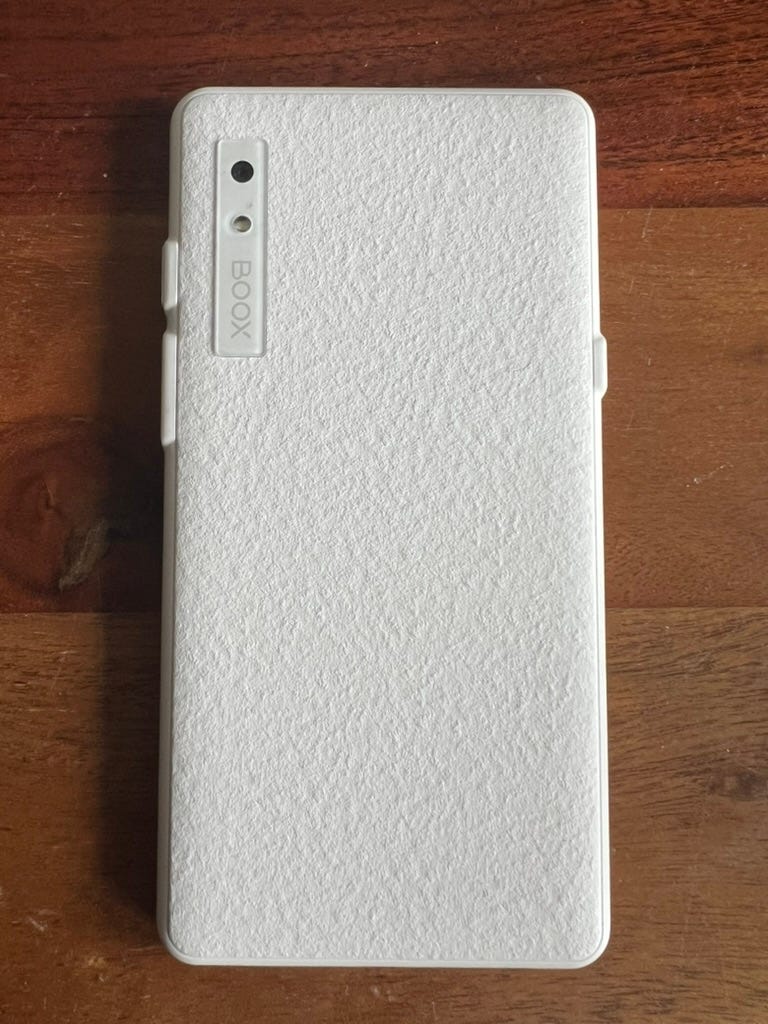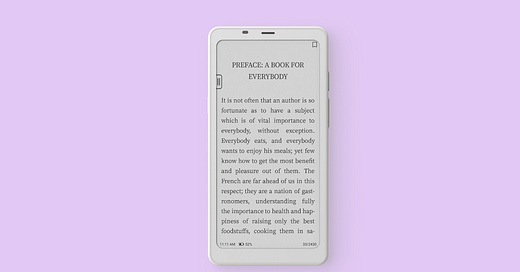Can an e-ink handset help my phone addiction?
The old "yes and no" response.
You know that thing? That thing we’re doing here at The Rectangle? The Great Uncoupling™? Where I’m trying to remove my phone from the centre of my digital life?
Well, we’re back at it again. But this time we’ve moved from theory into application — specifically, my attempt at using an e-ink handset.
Rather than just straightforwardly reviewing it though, I’m taking a different approach. Yes, you guessed it, I’m going to chat with myself.
What?
You heard, a self conversation. A little personal slap-and-tickle.
No, I’m not going to engage with that.
That’s fine.
Whatever. So… I’m meant to be you?
Basically me, but different.
Okay, this is getting weighed down by its own idiocy. Just tell me about this e-ink device.
It’s called the BOOX Palma 2.
Basically, it’s a phone-sized handset with Wi-Fi and an e-ink display.
And what’s an e-ink display?
That’s the same sort of technology ereaders like the Kindle use. It’s the sort of screen that resembles paper.
On top of that, the Palma 2 also runs Android, meaning you can use regular apps on the little device. Which is important for this whole… thing.
Okay, but why? Why not use a phone?
That’s a great point, and it gets to the crux of this piece and the Palma 2 itself.
One of the key elements of The Great Uncoupling™ is realising how much I both rely on and am addicted to my phone. The goal is to separate myself from the device, but without losing as many features as possible.
And this is where the Palma 2 comes in.
Broadly, this can do everything my phone can do, but without the pesky addictiveness. Or so my theory goes.
But the Palma 2 is still a phone-like device? Why isn’t it addictive?
A lot of that is down to the e-ink display. Because it’s nowhere near as responsive as an OLED screen, it makes doing anything other than reading or simple browsing slightly tiresome.
The black-and-white e-ink display is a little sluggish — it’s perfect for diving into a novel, but trying to watch a video is not a whole lot of fun.
And that’s the entire point.
Right, I get it. Tell me about how the Palma 2 works for you.
Generally, it’s been a delight. The screen is bright and getting apps working was easy. I was surprised at just how usable a phone with an e-ink display is.
Of course, there are trade-offs. The build quality isn’t amazing, and the Palma 2 has the specs of a pretty old phone, so it’s not whip-fast. On top of that, it’s made from a cheap-feeling plastic, meaning the device doesn’t feel as premium as something like the Kindle.
But you know what? It’s about €300. You can’t expect the world at that price, especially for something with as many features as the Palma 2.
It’s basically an e-ink Swiss Army Knife.
And did it work? Did it help with The Great Uncoupling™
Generally, yeah. The nature of the device and how I set it up made squandering time on TikTok or YouTube basically impossible.
This had its intended impact, making it far more likely I’d read an article or try learning Dutch on the Palma 2 than pump hours into social media.
But because it has the ability to run regular apps, albeit in a slightly painful way, it also works as a backup for my phone — which is how this whole thing started.
For example, I can easily access my banking app or a boarding pass on the Palma 2 if my main driver gives up the ghost.
The Palma 2 sounds perfect!
Well…
Uh oh, what’s wrong?
Let’s be clear: the Palma 2 is cool. I like it a lot, but it hasn’t quite solved my problem. The issue with the Palma 2 is, in a weird way, more about what it’s not than what it is.
My goal is to have a device that sits alongside my phone, but that can also replace it when needs be — and without support for a mobile network, the Palma 2 doesn’t completely manage that.
This puts it in a strange spot.
If I’m reading a book, I’d prefer something with a bigger screen. And if I’m going out of the house for an extended period of time, I need my phone for WhatsApp, communication, and a few other tasks that are easier on a responsive screen.
This means that for my use case, I generally ended up taking it and my regular phone. Over time, this meant I stopped using the Palma 2 so much, gently settling into my old habits.
Not my desired outcome.

That sounds like a “you” problem
Yup, can’t deny that.
I was after a device that wouldn’t necessarily replace my phone, but would complement it — and the Palma 2 is so very, very close to achieving that.
Yet for my use case, the lack of a mobile network really hampers it. All it needs is multi-sim support, the same thing that many wearable devices have. If I could add this onto my phone bill and have access to mobile service, it would elevate the Palma 2 into a full on handset replacement.
Unfortunately though, I’ve reverted back to using my phone more.
So: what’s the final verdict?
The BOOX Palma 2 is cool as hell. If a flexible palm-sized ereader sounds like something you’re after, then this is for you.
The handset is charming and an ideal antidote to this intense digitalism we’re living through. I’d say its best use comes at home. If you can put your phone somewhere out of reach and carry around the Palma 2 instead, it can help you alter your habits and use your time better.
Yet it just stops short of being able to replace a phone. For some people, that’s grand, but for me, it wasn’t quite enough.
The Palma 2 is going to stay in my device rotation and I have a lot of love for it, but it looks like The Great Uncoupling™ will continue to march on.









Thank you for your perspective. I am currently also reviewing the Palma 2 and will publish my notes & review in a few weeks.
I feel very similarly to what you are describing. I wish it had an eSIM and I think that’s one of the biggest things everybody points out. Especially when you want to go to the coffee shop with just one device in your pocket.
Yet, for what it is, it’s quite remarkable and really helps step back more, read in a calmer environment, and stay focused more easily.
Cheers.